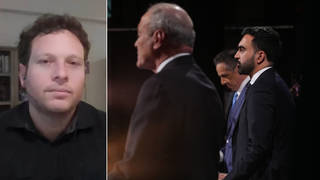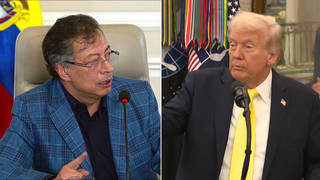
Guests
- Jay Stanleysenior policy analyst with the Speech, Privacy and Technology Project at the American Civil Liberties Union. He wrote a major report on the topic in 2013 titled “Police Body-Mounted Cameras: With Right Policies in Place, a Win for All,” and updated it this year with new ways to address civil rights concerns.
The murder charges filed against North Charleston police officer Michael Slager for fatally shooting Walter Scott has reignited debate over whether officers should wear body cameras. Police were forced to change their story that Slager fired his gun because he feared for his safety, after Feidin Santana came forward with video of the encounter he filmed on his cellphone. The video shows Slager fired eight times as Scott was running away from him. The original police report said Scott took Slager’s Taser and that officers tried to revive him with CPR. The video appears to show neither claim is true. On Wednesday, North Charleston Mayor Keith Summey announced a new order for police body cameras. Today, investigators are expected to release the dash-cam video from Slager’s patrol car. Many cities have installed cameras in their patrol cars. The Police Executive Research Forum surveyed police departments in 2013 and found about a quarter of respondents required body cameras. We are joined by Jay Stanley, senior policy analyst with the Speech, Privacy and Technology Project at the American Civil Liberties Union. Stanley wrote the 2013 report, “Police Body-Mounted Cameras: With Right Policies in Place, a Win for All,” and updated it this year with new ways to address civil rights concerns.
Transcript
JUAN GONZÁLEZ: The murder charges filed against North Charleston police officer Michael Slager for fatally shooting Walter Scott have reignited debate over whether officers should wear body cameras. Police were forced to change their story that Slager fired his gun because he feared for his safety, after a young man now identified as Feidin Santana came forward with video of the encounter he filmed on his cellphone. The video shows Slager fired eight times as Scott was running away from him.
AMY GOODMAN: The original police report said Scott took Slager’s Taser and that officers tried to revive him with CPR. The video appears to show neither claim is true. During a news conference about the shooting Wednesday, North Charleston Mayor Keith Summey announced a new order for body cameras.
MAYOR KEITH SUMMEY: We received a grant to purchase 101 body cameras. Those body cameras are on order. Today, I made an executive decision and have notified my council. We have already ordered this morning an additional 150 body cameras, so that every officer that’s on the street in uniform will have a body camera.
AMY GOODMAN: Today, investigators are expected to release the dash-cam video from Officer Slager’s patrol car. Many cities have installed cameras in their patrol cars. The Police Executive Research Forum surveyed police departments in 2013 and found about a quarter of respondents required body cameras.
Well, for more on whether more police should wear body cameras, we’re joined by Jay Stanley, senior policy analyst with the ACLU’s Speech, Privacy and Technology Project. He wrote a major report in 2013 titled “Police Body-Mounted Cameras: With Right Policies in Place, a Win for All,” and updated it this year with new ways to address civil rights concerns.
We only have a few minutes, Jay Stanley. Welcome to Democracy Now! Can you respond to the North Charleston Police Department saying they’re getting police cams for everyone? They’re going to train them, and they’re going to put them on them. What you think is good about this, and are you concerned about any issues around police being armed with body cameras around the country?
JAY STANLEY: Again, we think, overall, that body cameras can be a good thing that really help address this very serious problem of police abuse that we have around the country and that a lot of people’s eyes are being open to. But there are a lot of concerns. We don’t want them to become just another mass surveillance tool. And we want to make sure that they actually do provide the oversight. So the actual policies that surround the cameras—you can’t just slap cameras on police officers and think you’re done. It has to be surrounded with good policies that, first of all, protect privacy, because police officers are—they’re going into people’s homes, are encountering people at the worst moments of their lives, and people need to have confidence that that kind of video is not going to end up on YouTube, or they might be afraid to call the police for help when they need it. And second of all, you have to make sure that the police officers can’t control the video to such an extent that they can edit on the fly, turn the video off, engage in abuse, turn it back on, make it look like they were doing a proper job when actually they were involved and they were engaging in abuse.
So, you know, if I were a citizen of North Charleston, I would say, great, I’m glad you got the cameras. This can give us some confidence in our community, you know, and hopefully make an officer think twice before he or she does something like what we saw in that terrible video. But I would also say, I want to know what your policies are here. How are you going to enforce against police officers the policies that require them to turn them on when there’s any kind of law enforcement action? Because if you don’t do that, we’re going to see what we have seen, unfortunately, in other cities around the country, where police officers just don’t turn them on, or they don’t turn the video in, and there is no consequences for those officers. In that case, the videos are probably not a good thing. They’re probably just, you know, another surveillance tool to help the police only.
AMY GOODMAN: Well, we’re going to continue to have this discussion. Jay Stanley, I want to thank you for being with us, senior policy analyst with the ACLU’s Speech, Privacy and Technology Project. And we will link to your report on “Police Body-Mounted Cameras: With Right Policies in Place, a Win for All,” you write.












Media Options